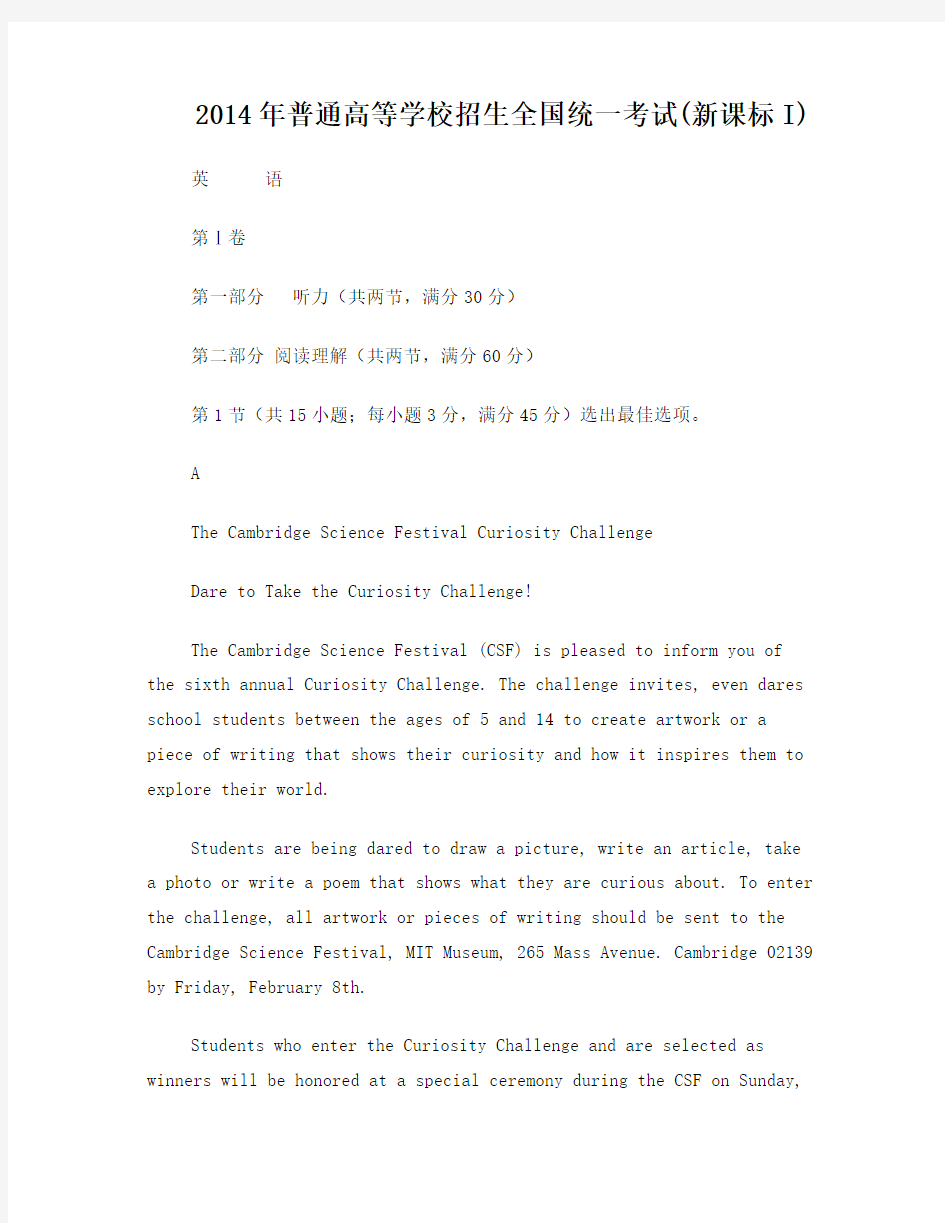
2014年全国高考英语全国卷
- 格式:doc
- 大小:35.50 KB
- 文档页数:10


2014年普通高等学校招生全国统一考试(新课标I)
英语
第Ⅰ卷
第一部分听力(共两节,满分30分)
第二部分阅读理解(共两节,满分60分)
第1节(共15小题;每小题3分,满分45分)选出最佳选项。
A
The Cambridge Science Festival Curiosity Challenge
Dare to Take the Curiosity Challenge!
The Cambridge Science Festival (CSF) is pleased to inform you of the sixth annual Curiosity Challenge. The challenge invites, even dares school students between the ages of 5 and 14 to create artwork or a piece of writing that shows their curiosity and how it inspires them to explore their world.
Students are being dared to draw a picture, write an article, take a photo or write a poem that shows what they are curious about. To enter the challenge, all artwork or pieces of writing should be sent to the Cambridge Science Festival, MIT Museum, 265 Mass Avenue. Cambridge 02139 by Friday, February 8th.
Students who enter the Curiosity Challenge and are selected as winners will be honored at a special ceremony during the CSF on Sunday,
April 21st. Guest speaker will also present prizes to the students. Winning entries will be published in a book. Student entries will be exhibit and prizes will be given. Families of those who take part will
be included in the celebration and brunch will be served.
Between March 10th and March 15th, each winner will be given the specifics of the closing ceremony and the Curiosity Challenge celebration. The program guidelines and other related information are available at: .
1. Who can take in the Curiosity Challenge?
A. School students.
B. Cambridge locals.
C. CSF
winners. D. MIT artists.
2. When will the prize-giving ceremony be held?
A. On February 8th.
B. On March 10th
C. On March
15th.. D. On April 21st.
3. What type of writing is this text?
A. An exhibition guide.
B. An art show review.
C. An announcement.
D. An official report.
B
Passenger pigeons(旅鸽)once flew over much of the United States
in unbelievable numbers. Written accounts from the 18th and 19th centuries described flocks so large that they darkened the sky for hours.
It was calculated that when its population reach its highest point, there were more than 3 billion passenger pigeons – a number equal to 24 to 40 percent of the total bird population in the United States, making it perhaps the most abundant birds in the world. Even as late as 1870 when their numbers had already become smaller, a flock believed to be 1 mile wide and 320 miles (about 515 kilometers) long was seen near Cincinnati.
Sadly, the abundance of passenger pigeons may have been their undoing. Where the birds were abundant, people believed there was an ever-lasting supply and killed them by the thousands. Commercial hunters attracted them to small clearings with grain, waited until pigeons had settled to feed, then threw large nets over them, taking hundreds at a time. The birds were shipped to large cities and sold in restaurants.
By the closing decades of the 19th century, the hardwood forests where passenger pigeons nested had been damaged by Americans’ need for wood, which scattered(驱散)the flocks and forced the birds to go farther north, where cold temperatures and spring storms contributed to their decline. Soon the great flocks were gone, never to be seen again.
In 1897, the state of Michigan passed a law prohibiting the killing of passenger pigeons, but by then, no sizable flocks had been seen in the state for 10 years. The last confirmed wild pigeon in the United States was shot by a boy in Pike County, Ohio, in 1900. For a time, a few birds survived under human care. The last of them, known affectionately as Martha, died at the Cincinnati Zoological Garden in September 1, 1914.
4. In the 18th and early 19th centuries, passenger pigeons _______.